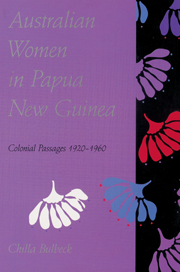Book contents
- Frontmatter
- Contents
- Photographs
- Acknowledgements
- Maps of Papua New Guinea
- Abbreviations
- Introduction
- 1 Passages to Papua New Guinea
- 2 Different Destinations
- 3 White Women in Papua New Guinea: Relative Creatures?
- 4 In Town and Down the Road
- 5 War, a Watershed in Race Relations?
- 6 The Civilising Mission
- 7 Matters of Sex
- 8 Making a Space for Women
- Appendix 1 Biographical Notes
- Appendix 2 Key Events in Chronological Order
- Notes
- Bibliography
- Glossary
- Index
3 - White Women in Papua New Guinea: Relative Creatures?
Published online by Cambridge University Press: 22 August 2009
- Frontmatter
- Contents
- Photographs
- Acknowledgements
- Maps of Papua New Guinea
- Abbreviations
- Introduction
- 1 Passages to Papua New Guinea
- 2 Different Destinations
- 3 White Women in Papua New Guinea: Relative Creatures?
- 4 In Town and Down the Road
- 5 War, a Watershed in Race Relations?
- 6 The Civilising Mission
- 7 Matters of Sex
- 8 Making a Space for Women
- Appendix 1 Biographical Notes
- Appendix 2 Key Events in Chronological Order
- Notes
- Bibliography
- Glossary
- Index
Summary
The men who conquer the feminine landscape of Africa overpower a ‘ravished dark woman’. But there are also real women in the tropics, though they too are often characterised as dark and untameable. The myths of the Amazons are re-invoked to align the female ‘Wild Women’ of the New World with the land in which they live: both a feminine temptation and challenge to the masculinity of white male explorers and settlers. This myth keeps the white civilised woman at home, lest she too descends to the level of the savage woman, to the level of nature. Thus the mother country stands for the safe and confining ‘home’ and the colonies for a farflung exterior world yet to be tamed by white men.
Claudia Knapman suggests the ‘imagery of the Empire was feminine’ characterised by Britannia and ruled by Queen Victoria (in all her prudery). But the Empire was feminine in two distinct registers. The cloistered mother country, represented by the purity of middle-class white women, was contrasted with the untamed seductiveness of the frontier, represented by the animal passions of the ‘Wild Women’. Thus expectant mothers retired home to deliver their babies in safety; wives, defeated by the rigours of frontier life, also retreated. In 1887 Lawes noted that ‘only five ladies have attempted to live in British New Guinea. Of these two died, and the third is just leaving—now so reduced by fever that her only hope of life is in getting away’.
- Type
- Chapter
- Information
- Australian Women in Papua New GuineaColonial Passages 1920–1960, pp. 64 - 99Publisher: Cambridge University PressPrint publication year: 1992



